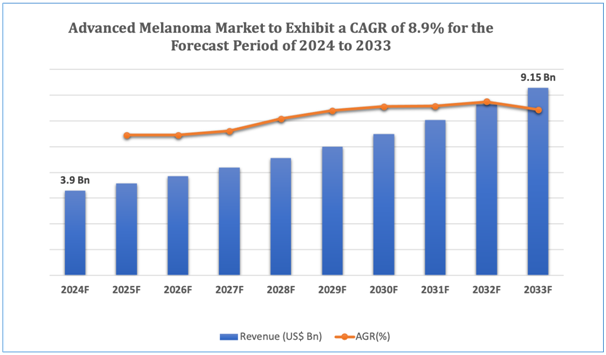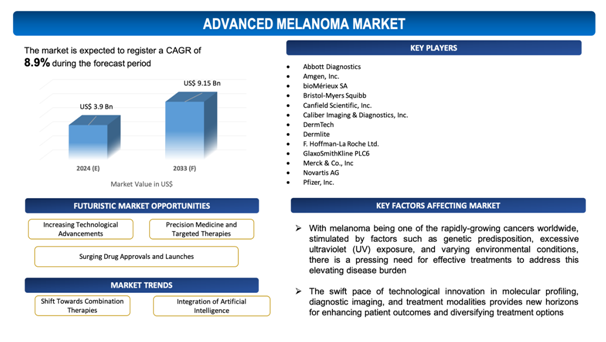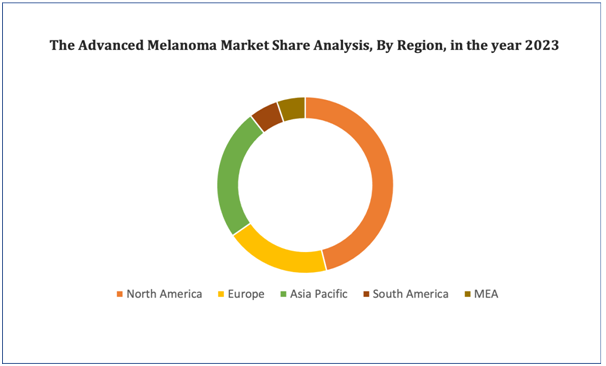Advanced Melanoma Market Overview
The global Advanced Melanoma market is estimated to be worth over USD 9.15 Bn in 2033 and is expected to grow at CAGR of8.9% during the forecast period (2024-2033).
Advanced melanoma, a dauntingsubset of skin cancer, stands as a substantialworldwide health concern attributing to its hostile nature and propensity for metastasis. The global market for advanced melanoma indicates the pressing need for efficient treatment alternatives to address the growing incidence of this malignancy across the globe. Contributing factors to the greater prevalence of advanced melanoma comprisegenetic predisposition, exorbitant ultraviolet (UV) exposure, and environmental factors. Significant advancements in understanding melanoma pathogenesis and molecular drivers have encouraged the development of targeted therapies and immunotherapies, redefining the treatment landscape.
Immunotherapeutic agents, such as immune checkpoint inhibitors targeting programmed cell death protein 1 (PD-1) and cytotoxic T-lymphocyte-associated protein 4 (CTLA-4), have illustratedexceptional efficacy in enhancing patient outcomes. In addition to that, targeted therapies directed against specific mutations, especially BRAF inhibitors for patients with BRAF V600 mutations, have displayedremarkable clinical benefits. These innovative treatment modalities have revolutionized the prognosis for patients with advanced melanoma, resulting intheenhanced survival rates and quality of life.
Along with that, advancements in diagnostic techniques, comprising molecular profiling and liquid biopsy assays, facilitate early detection of melanoma and identification of actionable mutations, promoting personalized treatment approaches. The global market for advanced melanoma is marked by a competitive landscape, with pharmaceutical firms investing in research and development to introduce novel therapeutics and combination regimens. Along with that, educational initiatives and advocacy efforts aimed at raising awareness about skin cancer prevention, early detection, and treatment alternatives contribute to market growth.
Regardless of these advancements, challenges such as treatment resistance, adverse effects related to therapies, and access to innovative treatments in underserved regions persist. Thereby, sustained research and innovation are imperative to address unmet medical needs and enhance patient outcomes in the global fight against advanced melanoma. Through joint efforts among healthcare stakeholders, there is promise for further innovations in treatment modalities and ultimately, improved prognoses for patients affected by this aggressive malignancy.
Figure 1. Advanced Melanoma: Market Size

Get more details on this report - Request Free Sample
Key Market Insights &Current Market Landscape:
The global advanced melanoma market presents a dynamic panoramadefined by substantial developments and technological breakthroughs. Notable market insights reflect a soaring demand for effective therapies to battle with this aggressive form of skin cancer. Significant developments comprise the advent of immunotherapy and targeted therapy as frontline treatments, transforming the standard of care for advanced melanoma patients. Immunotherapeutic agents targeting immune checkpoint proteins like PD-1 and CTLA-4 have demonstratesnoteworthy efficacy in propelling the immune system's ability to combat cancer cells. In addition to that, targeted therapies aimed at specific genetic mutations, such as BRAF inhibitors for BRAF V600-mutant melanomas, have illustratedsignificant clinical benefits. The current market outlook is marked by a competitive environment with numerous pharmaceutical companies investing in research and development to introduce novel therapies and combination regimens. Furthermore, continuing advancements in diagnostic technologies, comprising molecular profiling and liquid biopsy assays, facilitate early detection of melanoma and inform personalized treatment approaches. Overall, the global advanced melanoma market continues to evolve at the rapid pace, fueled by a hope to enhance patient outcomes and addressing unmet medical needs through innovative therapies and diagnostic tools.
Market Dynamics
Market Drivers
Rising Prevalence of Melanoma Worldwide
With melanoma being one of the rapidly-growing cancers worldwide, stimulated by factors such as genetic predisposition, excessive ultraviolet (UV) exposure, and varying environmental conditions, there is a pressing need for effective treatments to address this elevating disease burden. The sharp surge in the prevalence of risk factors, along with enhanced awareness and early detection efforts, contributes to increased diagnosis rates of advanced melanoma. As a consequence, healthcare systems and pharmaceutical firms are bound to invest in research and development to meet the soaring demand for innovative therapeutic interventions. In addition to that, the increasing incidence of melanoma highlights the prominence of advancing diagnostic technologies and treatment modalities to enhance patient outcomes and survival rates. This escalated awareness of melanoma's prevalence across the world not only fuels investment in novel therapies but also facilitates collaboration among stakeholders in the healthcare industry to address the challenges associated with this aggressive malignancy, ultimately accelerating growth and innovation in the global advanced melanoma market.
Market Restraints
With regard to numerous advantages of Advanced Melanoma, the market faces several challenges due to the unique characteristics and requirements associated with them. Some of the key market challenges include:
- Treatment Resistance: Notwithstanding with the significant advancements, treatment resistance remains a major restraint in the global advanced melanoma market. Patients may develop resistance to immunotherapies or targeted therapies over time, resultingin disease progression and limited treatment options. This challenge underlines the need for persistent research to understand the underlying mechanisms of resistance and develop strategies to overcome it.
- High Treatment Costs: High treatment costs poses another notable restraint in the global advanced melanoma market. Advanced therapies such as immunotherapies and targeted therapies can be high-priced, restricting access for patients, specifically in regions with limited healthcare resources. Addressing affordability issues and expanding access to cost-effective treatment alternatives are critical for enhancing patient outcomes and mitigating the economic strain of advanced melanoma treatment.
Market Opportunities
Increasing Technological Advancements
The swift pace of technological innovation in molecular profiling,diagnostic imaging, and treatment modalities provides new horizons for enhancing patient outcomes and diversifying treatment options. Advanced imaging techniques, such as positron emission tomography (PET) scans and magnetic resonance imaging (MRI), facilitate more precise staging of melanoma, promoting early detection and accurate localization of metastases. In addition to that, molecular profiling technologies, comprising next-generation sequencing (NGS) and liquid biopsy assays, enable for thorough genomic analysis of melanoma tumors, guiding personalized treatment strategies on the basis of individual genetic alterations. Along with that, technological innovations in therapeutic modalities, such as the development of novel immunotherapies and targeted therapies, persist to transform the treatment panorama for advanced melanoma. These innovations not only improve treatment efficiency but also mitigate adverse effects, enhancing patient quality of life. Overall, the consolidation of technological advancements in diagnostics and therapeutics presents opportunities for advancing precision medicine approaches and addressing unmet medical requirements in the global advanced melanoma market. Sustained investment in research and development of leading-edge technologies is crucial for fueling further innovation and enhancing outcomes for patients with advanced melanoma.
Market Trends
- Shift towards Combination Therapies: There is a significant trend in the global advanced melanoma market towards the usage of combination therapies, comprising the simultaneous administration of immunotherapies and targeted therapies or the combination of different immunotherapy agents. This approach focuses on toimprove treatment efficacy by targeting multiple pathways involved in melanoma progression, overcoming treatment resistance, and improving patient outcomes.
- Integration of Artificial Intelligence (AI): The global advanced melanoma market is experiencing the integration of artificial intelligence (AI) in various aspects, involving diagnostic imaging interpretation, treatment planning, and drug discovery. AI-powered algorithms help in the evaluation of intricate imaging data, assisting clinicians in early detection, accurate staging, and personalized treatment decision-making. Along with that, AI-driven approaches contribute to drug development by predicting treatment response and identifying potential therapeutic targets, facilitating innovation and efficacy in melanoma management.

Get more details on this report - Request Free Sample
Advanced Melanoma Market: Key Segments
By Product Type
- Diagnostics
- Dermatoscopy Devices
- Biopsy Devices
- Therapeutics
- Chemotherapy
- Biological Therapy
- Targeted Therapy
- Immune Therapy
By End-User
- Hospitals
- Cancer Research Centres
- Academic Institutes
- Diagnostic Centers
- Ambulatory Surgical Centers
- Others
By Distribution Channel
- Hospital Pharmacy
- Online Pharmacy
- Retail Pharmacy
By Key Geographical Regions
- North America
- Europe
- Asia-Pacific
- Middle East and Africa
- South America
Advanced Melanoma Market: Regional Analysis
North America holds a dominant share of the market owing to the rising incidence of melanoma and other skin cancer cases in the region. According to the American Academy of Dermatology Association (AAD) updates from 2022, Skin cancer is the most common cancer in the United States. AAD also estimated that one in five Americans will develop skin cancer in their lifetime. Also, approximately 9,500 people in the United States are diagnosed with skin cancer every day. Also, according to the American Cancer Society, about 99,780 new melanomas will be diagnosed in the United States in 2022, and around 7,650 people are expected to die of melanoma in the same year. These statistics highlight the need for drugs that help in the management of melanoma over the coming years.
Figure 4. Advanced Melanoma Market: Distribution by Region

Get more details on this report - Request Free Sample
Leading Advanced Melanoma Developers
Industry Trends and Global Forecasts, 2023-2035 report features an extensive study of the current market landscape, market size and future opportunities associated with the Advanced Melanomamarket, during the given forecast period. Further, the market report highlights the efforts of several stakeholders engaged in this rapidly emerging segment of the biopharmaceutical industry. Key takeaways of the Advanced Melanomamarket are briefly discussed below.
The report includes the list of players operating in the global Advanced Melanomamarket. Some of the key players include:
- Abbott Diagnostics
- Amgen, Inc.
- bioMérieux SA
- Bristol-Myers Squibb
- Canfield Scientific, Inc.
- Caliber Imaging & Diagnostics, Inc.
- DermTech
- Dermlite
- F. Hoffman-La Roche Ltd.
- GlaxoSmithKline PLC6
- Merck & Co., Inc
- Novartis AG
- Pfizer, Inc.
Recent Developments in the Advanced MelanomaMarket
Several recent developments have taken place in the field of Advanced Melanoma, some of which have been outlined below. These developments, even if they took place post the release of our market report, substantiate the overall market trends that we’ve outlined in our analysis chronologically.
- In February 2024, The U.S. Food and Drug Administration (FDA) granted accelerated approval on Feb. 16 for lifileucel (Amtagvi) for adults with unresectable or metastatic melanoma who have been previously treated with a PD-1 blocking antibody, and if BRAF V600-positive, a BRAF inhibitor with or without a MEK inhibitor.Lifileucel, a tumor-derived autologous T-cell immunotherapy, is the first and only one-time T-cell therapy to receive FDA approval for a solid tumor cancer.
Scope of the Report
The market report presents an in-depth analysis of the various firms / organizations that are engaged in this market, across different segments, as defined in the below table:
|
Key Report Attributes |
Details |
|
Base Year |
2023 |
|
Forecast Period |
2024-2033 |
|
CAGR (2024-2033) |
8.9% |
|
Product Type |
|
|
End User |
|
|
Distribution Channel |
|
|
Key Geographical Regions |
|
|
Key Companies Profiled |
|
